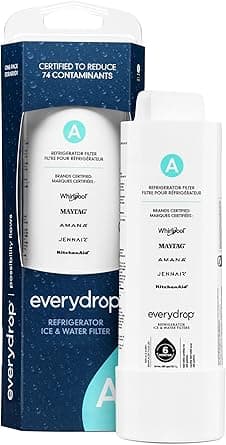Arlington Tap Water Quality Report
Arlington's water has 3 contaminants above EPA MCLGs. Consider using a certified water filter for additional protection.
Utility
ARLINGTON COUNTY
People Served
215,000
MCL Violations
0
Last Updated
2025-10-05
Is Arlington Tap Water Safe to Drink?
Arlington's water has 3 contaminants above EPA health-based guidelines (MCLGs). While the water meets federal legal limits, we recommend using a certified water filter for additional protection, especially for vulnerable populations like children, pregnant women, and those with compromised immune systems.
The data below shows test results from ARLINGTON COUNTY, which serves 215,000 people in the Arlington area. Water quality testing is conducted regularly and reported to the EPA. This report was last updated 2025-10-05.
Arlington Water Quality Test Results
Key Water Quality Metrics
Contaminants Detected
⚠️ Contaminants Above EPA MCLG (3)
Bromodichloromethane
What is Bromodichloromethane?
Member of trihalomethanes (THMs) that form in water treated with chlorine
Health Effects
Health protective benchmarks for BDCM are based on carcinogenicity and liver toxicity observed in animal studies. The EPA has classified BDCM as a probable human carcinogen. Results from animal studies also suggest that kidney, immune system, spleen, and developmental toxicity are associated with exposure to BDCM. BDCM has been shown to produce DNA changes (genotoxicity) in laboratory studies.
Affected Organs
Common Sources
Lead
What is Lead?
Naturally occurring heavy metal commonly found in tap water
Health Effects
Health protective benchmarks for oral exposure to lead are based on delays in physical or mental development for children and infants, and impacts to the kidneys and high blood pressure for adults. Children are especially susceptible to the effects of lead. Even low levels of lead can damage the brain and nervous system, slow development, and lead to problems with learning, behavior, hearing, and speech. In adults, lead can lead to hypertension, reproductive problems, neurological disorders, decreased kidney function and muscle and joint pain. Exposure to lead can also cause anemia and impact the immune system for both children and adults. The EPA classifies lead as a probable human carcinogen.
Affected Organs
Common Sources
Dichloroacetic Acid (DCA)
What is Dichloroacetic Acid (DCA)?
Member of haloacetic acids (HAAs) that form as byproducts when chlorine reacts with organic matter
Health Effects
Health protective benchmarks for DCA are based on evidence of increased cancer risk and liver toxicity observed in animal studies. Adverse effects to the male reproductive system have also been associated with elevated levels of DCA in animal studies. The EPA classifies DCA as a likely human carcinogen.
Affected Organs
Common Sources
Understanding the Data
This data comes from your local water utility testing. The bar charts compare detected levels against EPA's Maximum Contaminant Level Goal (MCLG). Contaminants above the MCLG are shown by default and may require filtration. All other tested contaminants are within safe levels and can be viewed by expanding the section above.
Recommended Water Filters for Arlington
Based on Arlington's water quality data, these NSF-certified filters are recommended to remove contaminants above EPA MCLGs.

Whirlpool Corporation
W11256135
NSF Certified:
Capacity
1001 gal
Filter Life
3 mo
Flow Rate
0.7 gpm
Removes 19 contaminants:
1,2 Dichlorobenzene, 1,4 Dichlorobenzene, 2,4-D, Asbestos, Atrazine +14 more

Whirlpool Corporation
W11569861
NSF Certified:
Capacity
1001 gal
Filter Life
3 mo
Flow Rate
0.52 gpm
Removes 22 contaminants:
1,2 Dichlorobenzene, 1,2,4 Trichlorobenzene, 1,4 Dichlorobenzene, 2,4-D, Asbestos +17 more

iSpring Water Systems LLC
RCC7-BLK
NSF Certified:
Daily Production
25.41 gpd
Removes 9 contaminants:
Asbestos, Barium, Cadmium, Chromium (Total), Copper +4 more

iSpring Water Systems LLC
RCC7AK-BLK
NSF Certified:
Daily Production
25.41 gpd
Removes 9 contaminants:
Asbestos, Barium, Cadmium, Chromium (Total), Copper +4 more
Frequently Asked Questions About Arlington Tap Water
Arlington's water has 3 contaminants above EPA MCLGs. While the water meets federal legal limits, we recommend using a certified water filter for additional protection, especially for vulnerable populations like children, pregnant women, and those with compromised immune systems.